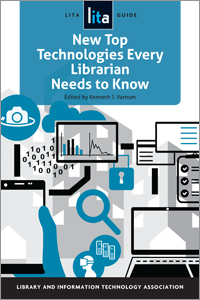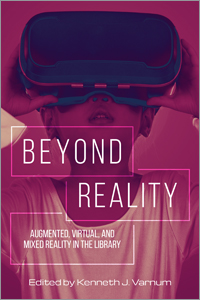Kenneth J. Varnum surveys top tech trends for libraries
If you want to learn about library technology, whether past, present, or future, Kenneth J. Varnum is exactly the right person to talk to. Senior Program Manager for Discovery, Delivery, and Library Analytics at the University of Michigan Library, he has more than two decades of experience working with public-facing technology in academic, corporate, and special libraries. And he seems to like staying busy: his newest books as editor, New Top Technologies Every Librarian Needs to Know and Beyond Reality: Augmented, Virtual, and Mixed Reality in the Library, were just published more or less simultaneously. Here we discuss tech trends, obsolescence, and how to get the most bang for your buck on a limited budget.
You’ve just edited two new books for ALA Editions about technology trends. Your LITA guide The Top Technologies Every Librarian Needs to Know first came out in 2014 . As you prepared the new volume, did you notice an overall direction in how library tech has changed over the last few years?
 If it’s possible, the scope and scale of how library technology changes continue to grow. Libraries and technology were becoming closely aligned five years ago, particularly in larger libraries of all kinds.
If it’s possible, the scope and scale of how library technology changes continue to grow. Libraries and technology were becoming closely aligned five years ago, particularly in larger libraries of all kinds.
One big change is that technology innovation and experimentation are ever more accessible to smaller libraries. Where five or ten years ago, technology might have been connected with a particular person or maybe a small department, responsibility for applications and integrations is much more broadly diffused across organizations.
Service models and library technology are still in a cycle of active co-evolution. Library service models increasingly rely on technology to provide them, and library technology continues to expose new possibilities of those service models. This virtuous cycle is far from homeostasis. The motivations for this continued integration and growth are multiple: user expectations, once-expensive technologies becoming affordable (or even cheap), and expertise developing in all areas of libraries.
What technology is headed towards obsolescence a lot more quickly than you would have thought?
What has surprised me most is how little actually becomes obsolete. Perhaps I shouldn’t be, but the fact that libraries are still using “ancient” technologies dating back to the 1990s for some of our core services is most surprising. Clever solutions for complex problems like Z39.50, OpenURL, proxy servers, and more, are all common features of the library technology ecosystem, coexisting with much more modern innovations. I can’t help but worry that our accretive technology stack will one day crumble under its own weight.
Among the themes explored in the new guide is automation, including bots and machine learning. I’m being a little tongue in cheek here, but should library workers themselves worry about becoming obsolete?
Obsolete? No. Needing to learn new skills, tools, techniques, and modes of thinking? Almost certainly yes.
New service models, driven by the interplay of technology’s potential and library’s service ethic, will keep humans employed in libraries far into the future. I don’t discount the possibility that computers will someday learn how to learn and be able to provide information about increasingly abstract questions. I do discount the likelihood that those answers will be good enough.
We have lived in the “Age of Google” for nearly two decades —close to a generation. Search tools are able to provide answers for basic factual questions with something resembling accuracy. That has led to a shift in how some libraries provide “ready reference” services. But I seriously doubt that the number of interchanges between people in the community with information needs and the people in the library with access to information resources has shifted.
Libraries also provide critical resources to help alleviate the effect of socioeconomic barriers to knowledge and access to computing power, not to mention providing instruction on how to effectively use both. As long as libraries continue their long tradition of teaching their users how to be responsible consumers of information (the book, the magazine/journal, the index, or the tool), library workers, as a collective, have nothing to fear. That’s not to say specific functions might change, but libraries will be no more devoid of library workers than they are of users today.
There’s always been a tension between cool new technology and libraries’ ability to pay for it. How are institutions finding ways to acquire and test it out despite their limited budgets?
The answer to this is as old as the problem: start small, with a pilot or experiment, partner with another library or institution, and let the new service grow from there to the degree that use demonstrates value for you. Some technologies in the book are big and expensive; many others are smaller and lend themselves. A library whose goal is to provide relevant service to the community it serves, and that can demonstrate that it does so, in the long run will be better able to fund new things.
 It’s always best to tie a proposed new service to specific needs within the community being served; those with the funds (however carefully they are administered) respond better to a proposal that shows how the technology will further the mission, so be sure to keep communication channels open with both the users and those who provide the budget.
It’s always best to tie a proposed new service to specific needs within the community being served; those with the funds (however carefully they are administered) respond better to a proposal that shows how the technology will further the mission, so be sure to keep communication channels open with both the users and those who provide the budget.
Your other new book surveys augmented, virtual, and mixed reality in the library. What advice can you give a library that’s considering the first steps to take in exploring this technology?
Start small. Anyone with a modern smartphone can experience simple VR with a simple (often made from cardboard) goggles that holds the phone and allows the user to see a stereoscopic view. Many of these experiences work with iPods, as well — a small investment to provide access to those without smartphones. Both iOS and Android smartphones and small tablets allow for augmented reality experiences, games where the camera shows the immediate environment and adds things to it. Step up from there to headsets and a computer to provide imagery. Consider partnering with local schools to match AR/VR/MR content to class projects or curricula. And then build capability from there.
Learn more at the ALA Store.
